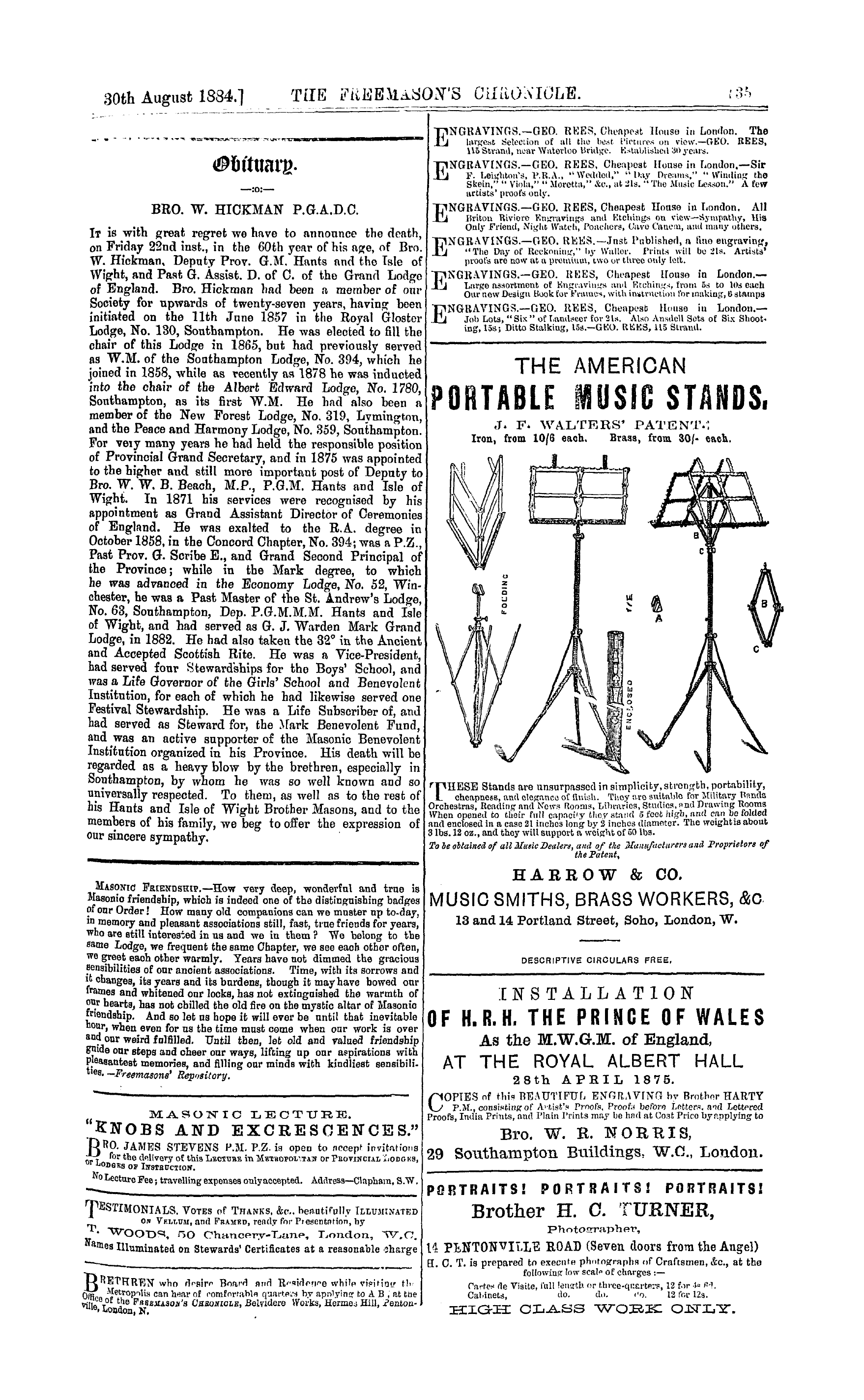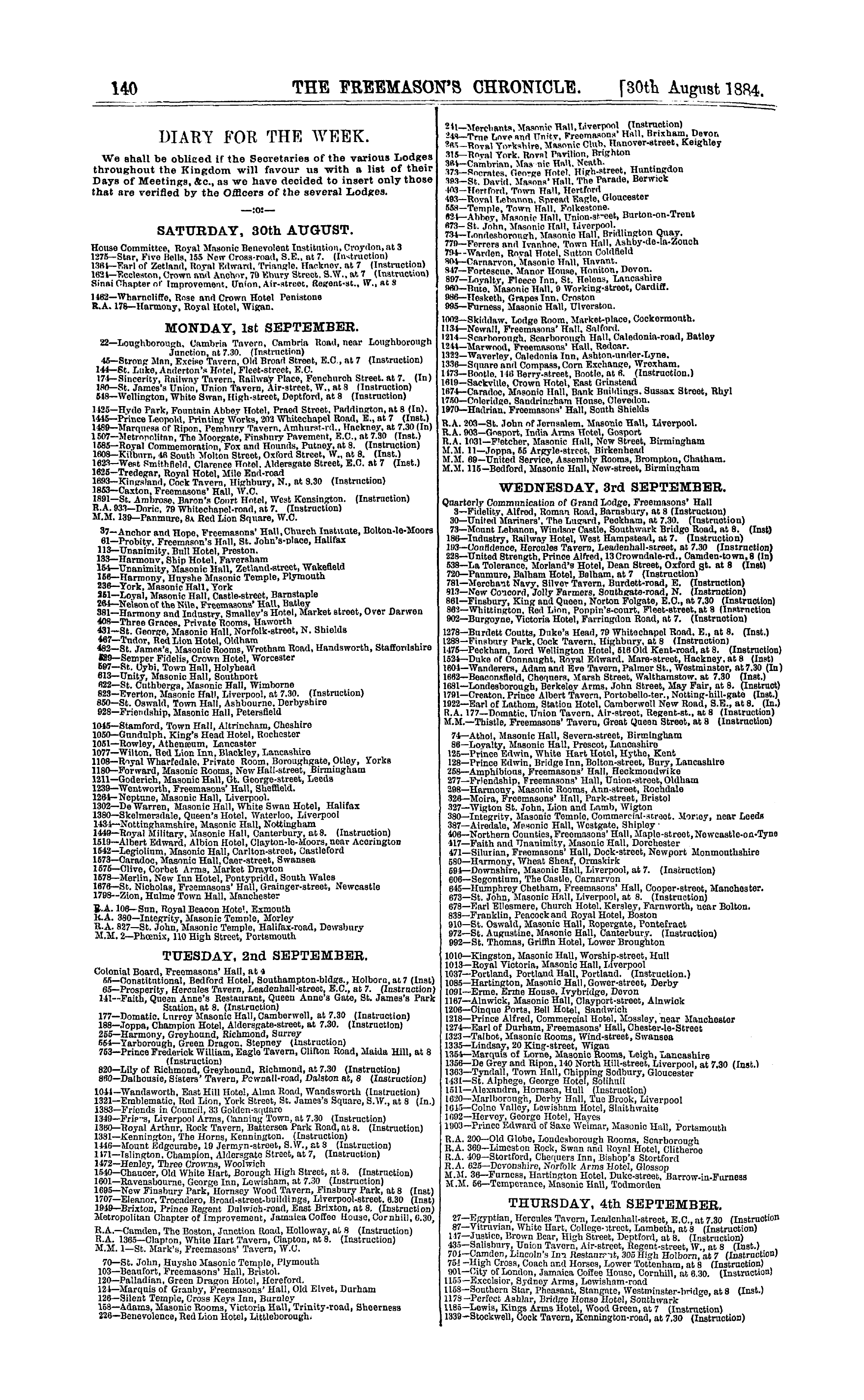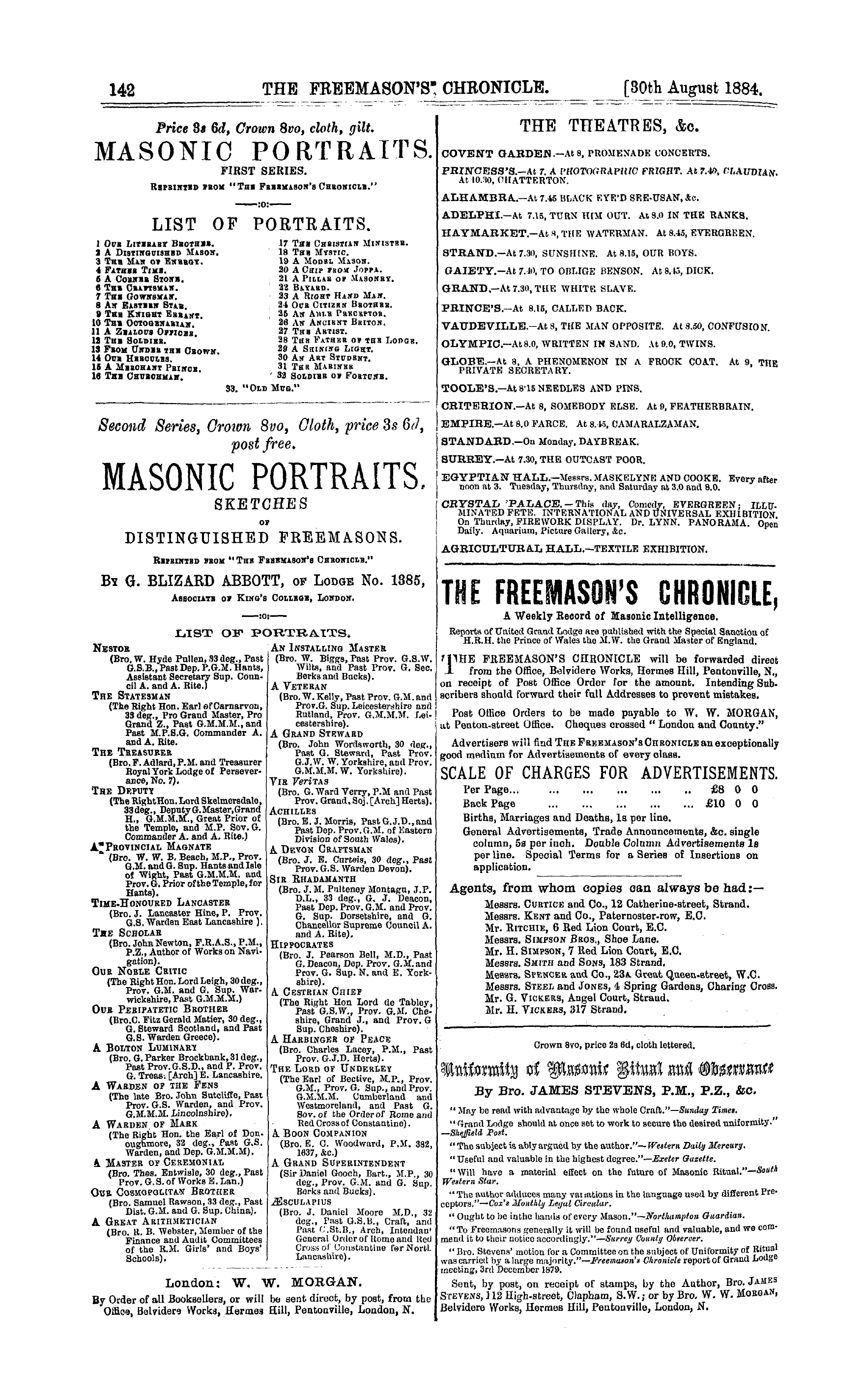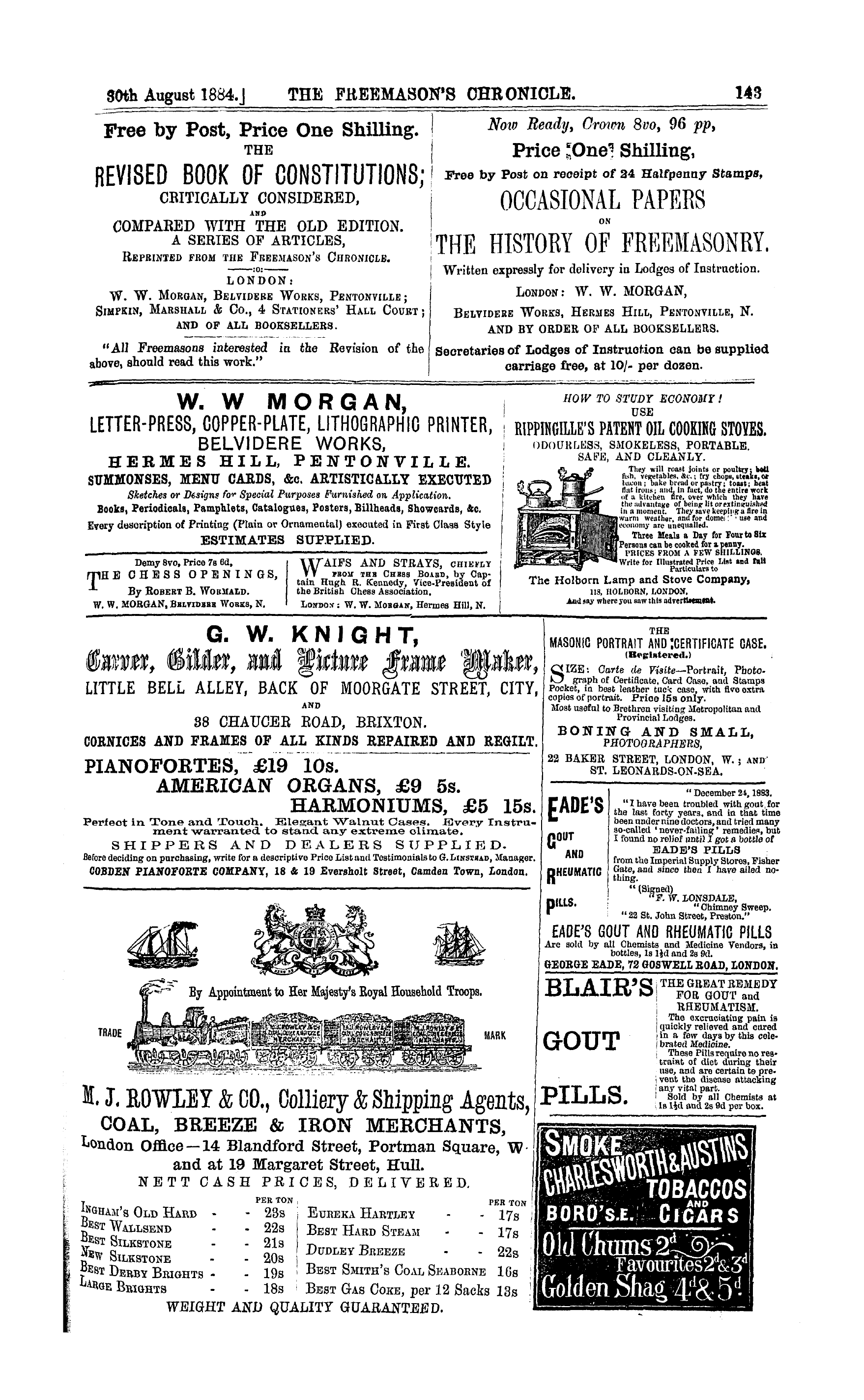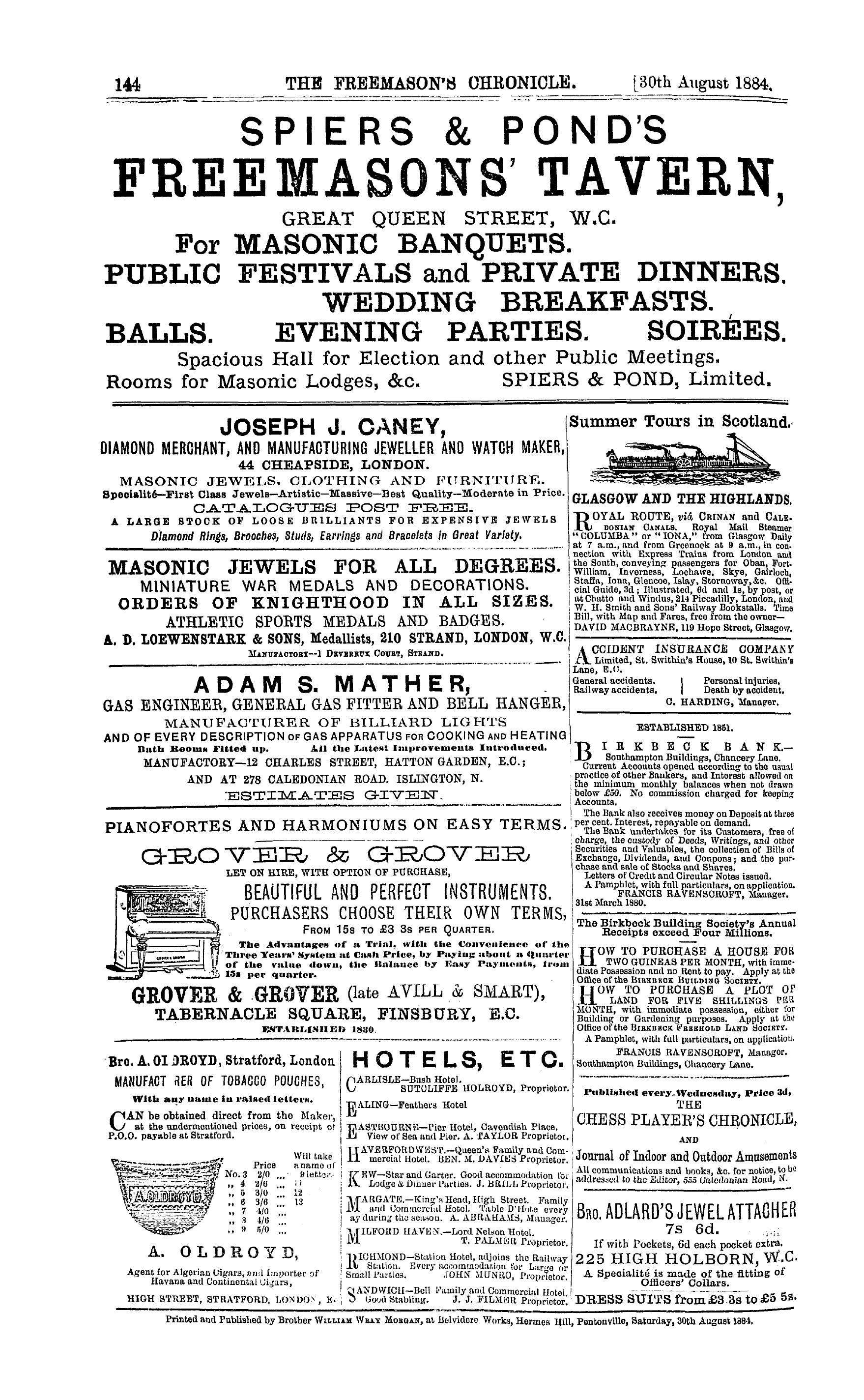-
Articles/Ads
Article FREEMASONRY IN SPAIN. ← Page 2 of 2 Article THE GREAT PYRAMID. Page 1 of 2 Article THE GREAT PYRAMID. Page 1 of 2 →
Note: This text has been automatically extracted via Optical Character Recognition (OCR) software.
Freemasonry In Spain.
Thus in 1809 the Supreme Council of France , and the Grand Orient of the same country , had both established off-shoots in Spain , the Grand Orient , ruled by the Count Montijo , alone representing the original English element according to the Anderson system , but independent and con
fined wholly and solely to brethren of Spanish blood . The former Minister of State , Azanza , was nominated Grand Master of the new Grand Orient born in 1809 of French origin . In 1811 , tho Count de Grasse-Tilly , being dissatisfied with the manner in which his brother the Count
de Tilly conducted the affairs of the Supreme Council of Spain , constituted a second Supreme Council on the 4 th July , and the better to vindicate its dependence on French Masonic authority , he installed , in tho capacity of Grand Commander of this new power , tho same Azanza , who for
the preceding two yrars had held the office of Grand Master of the Grand Orient of Spain , under the protection of the Grand Orient of France . Consequently , there were at this epoch four Supreme Masonic authorities in Spain : Grand Orient , No . 1 , founded 1780—Spanish ; Supreme
Council , No . I , founded 17 th September 1808 , also Spanish ; and the Grand Orient , No . 2 , founded 3 rd November 1809 , and Supreme Council , No . 2 , founded 4 th Jul y 1811 , both of French origin . Snch was the state of things when Ferdinand VII . returned to Spain , and by his decree of the 4 th May 1814
closed all the Lodges , placing them outside the pale of the law , and inaugurated a second era of persecution against Freemasonry , the first dating from 1751 . But hereabouts is the obscure point in the history of Spanish Freemasonry .
In 1817 there would have been signed a treaty of union between Grand Orient , No . 1 and Supreme Council , No . 1 , by which the Count de Montijo should have become Grand Master of the Grand Orient and Grand Commander
of the Supreme Council just as the Minister Arguelles , successor of Minister Azanza was Grand Master of the Grand Orient , No . 2 and Grand Commander of the Grand Council No . 2 , but no documentary evidence
of this treaty has ever been forthcoming . It is asserted that in 1818 Supreme Council No . 2 had absorbed Supreme Council No . 1 , or rather that the Grand Inspectors General of the two Councils had combined for the
purpose of deliberating on the steps to be taken in order to secure the triumph of liberal ideas which took place in 1820 . General Riego , the brothers San MigneL'of whom one became Marshal , and Arguelles took part in the important deliberations on Madrid in 1818 . In 1823 a
clerical reaction set in . Riego , Grand Commander of the Sole Supreme Council and Grand Master of Grand Orient No . 2 , was shot and the third persecution of Freemasonry ¦ was initiated by the decree of Ferdinand VII . of 1 st August 1824 , condemning to death without trial every Freemason who did not submit himself to the clerical
authorities by the 31 st of the same month . But no submission followed , and the Inquisition secured many victims in the liberal ranks under pretext of their connection with Freemasonry . On 7 th March 1825 , a Lodge was surprised at
Grenada in the very midst of an initiation and the Master ( le Venerable ) and six others composing it were hanged there and then , while the candidate was condemned to the galleys for twelve years . ( To be continued . )
The Great Pyramid.
THE GREAT PYRAMID .
THERE is but one pyramid , and that the Great Pyramid of Cheops , or Gizeh . Seventy pyramids once stood on the margin of the Egyptian desert , but only one has a history hoary with age , and clothed with mystery . It was the parent , all others were imitations . Not only does
no contemporary descrip tion of it exist , but it stood a world-wonder for fifteen hundred years before any writer , whose works remain to us , gave an account of it . No
wonder we are in the dark concerning it ; no wonder all manner of speculations have been made as to its origin and purpose . Probably we shall never know the exact truth about it . We are too far removed from it in time , and
know too little about the history of Egypt , at the period of its erection , to justify any one in asserting positively why it was built , or to what purpose it was originally devoted . One thiug , however , is certain—it is an everlasting monument to the Masonic art , a continuing example
The Great Pyramid.
of the skill of the operative Masons of three thousand years ago . There is no end to the fanciful theories of intellectual speculators abont the Great Pyramid . John Taylor , Prof Piazzi Smyth , H . C . Agnew , Joseph A Seiss , D . D ., J . Ral *
ston Skinner , Everett W . Fish , M . D , W . M . Flinders Petrie , William Rowbottom , Robert Hewitt Brown , and others , have created a Pyramid literature , that of itself constitutes in size no mean library . The latest contribu . tion to the literature of the subject is of the destructive
order , from the pen of President Barnard , of Columbia Collego , New York * President Barnard is an ardent advocate of the introduction of tbe Metric system of weights and measures in this country , and he has attacked the theories of the fanciful school of Pyramidalists with
considerable power , his purpose evidently being to abolish the idea that our English inch measure bears any relation to the so-called sacred cubit , whioh should justify its retention , and thus influence the exclusion of the Metric system . His work is written with grace and scholarl y
tact , and affords pleasant reading on a recondite subject . He argues that the Great Pyramid was simply a royal tomb , and that all the striking scientific analogies discovered in connecion -with it are merely remarkable coin - cidences . Now , while we have no doubt this world-wonder
was a royal tomb , we believe it was also much more . As Bro . Harry Hazel some years ago observed , in the columns of the Keystone , " That Cheops at his death might have been buried in it , if he was its founder , is likely enough , for the interment of a man of eminence in , under or near a
religious edifice , and especially when he is regarded as its founder , is often esteemed , even at the present day , not too high an honour for a human being . But the internal passages and chambers of Cheops disprove tbe theory that it was erected merely for a tomb ; and even had the
mummified remains of the renowned king been discovered m the Great Pyramid , it would afford no greater proof for the tomb theory , than the discovery of a bishop ' s body beneath the pulpit or chancel of a church would for tbe assumption that the building had been put up expressly to cover the remains of the distinguished ecclesiastic . "
It is not easy to comprehend the great antiquity of this monument . Abraham saw it , and Joseph spent a large part of his life in its vicinity . P . G . M . Bro . Rob Morris LL . D . ( who has several times visited it ) , has pointedly said : " When Solomon planted the Corner-stone of his
Temple on Mount Moriah , that of the Pyramid had been laid twelve hundred years ! " Wonderful in antiquity , in structure , and in purpose , is the only wonder remaining to us of the original " seven wonders of the world . " * We think it is a fair deduction from what we positively
know of the structure of tbe pyramid , and the customs of the people iu the era in which it was erected , that it was , primarily , a Temple of the Snn . This is , no doubt , a heathenish conclusion , but it appears to be a reasonable one . It was also , contemporaneously or subsequently ,
used for astronomical or astrological purposes . Many of the most ancient temples were dedicated to the Snn , and the priests and soothsayers of the times were called upon to aid at the inception of the building , by the performance of what were thought to be fitting ceremonies . Tacitus ,
in the fourth book of his History , gives a very striking description of the laying of the Corner-stone of the Capital at Rome , when rebuilt by the Emperor Vespasian , on
which occasion " Helvidius Prisons , the praetor , preceded by Plautius Alianus , the pontiff , invoked Jupiter , Juno and Minerva , to prosper the undertaking , " and then " loosed the wreaths that bound the foundation stone . "
In this connection we may observe , that , as is known , the Corner-stone is always laid at the North-East corner of the edifice . Why ? This , too , is a relic of Sun worship . The Corner-stone of the Capitol at Rome , to which we have just referred , Tacitus says was laid the " eleventh day
before tbe calends of July " —that is , ab the period of the summer solstice , the great solar festival , when the Sun reached his highest Northern declination . Now , the
heathen temples always face the sun , so as to catch the first rays of the rising orb , and since at the end of June the sun rises a little North of East , the North-Fast corner of the Temple at that time is in the direct line of the rising sun ,
Note: This text has been automatically extracted via Optical Character Recognition (OCR) software.
Freemasonry In Spain.
Thus in 1809 the Supreme Council of France , and the Grand Orient of the same country , had both established off-shoots in Spain , the Grand Orient , ruled by the Count Montijo , alone representing the original English element according to the Anderson system , but independent and con
fined wholly and solely to brethren of Spanish blood . The former Minister of State , Azanza , was nominated Grand Master of the new Grand Orient born in 1809 of French origin . In 1811 , tho Count de Grasse-Tilly , being dissatisfied with the manner in which his brother the Count
de Tilly conducted the affairs of the Supreme Council of Spain , constituted a second Supreme Council on the 4 th July , and the better to vindicate its dependence on French Masonic authority , he installed , in tho capacity of Grand Commander of this new power , tho same Azanza , who for
the preceding two yrars had held the office of Grand Master of the Grand Orient of Spain , under the protection of the Grand Orient of France . Consequently , there were at this epoch four Supreme Masonic authorities in Spain : Grand Orient , No . 1 , founded 1780—Spanish ; Supreme
Council , No . I , founded 17 th September 1808 , also Spanish ; and the Grand Orient , No . 2 , founded 3 rd November 1809 , and Supreme Council , No . 2 , founded 4 th Jul y 1811 , both of French origin . Snch was the state of things when Ferdinand VII . returned to Spain , and by his decree of the 4 th May 1814
closed all the Lodges , placing them outside the pale of the law , and inaugurated a second era of persecution against Freemasonry , the first dating from 1751 . But hereabouts is the obscure point in the history of Spanish Freemasonry .
In 1817 there would have been signed a treaty of union between Grand Orient , No . 1 and Supreme Council , No . 1 , by which the Count de Montijo should have become Grand Master of the Grand Orient and Grand Commander
of the Supreme Council just as the Minister Arguelles , successor of Minister Azanza was Grand Master of the Grand Orient , No . 2 and Grand Commander of the Grand Council No . 2 , but no documentary evidence
of this treaty has ever been forthcoming . It is asserted that in 1818 Supreme Council No . 2 had absorbed Supreme Council No . 1 , or rather that the Grand Inspectors General of the two Councils had combined for the
purpose of deliberating on the steps to be taken in order to secure the triumph of liberal ideas which took place in 1820 . General Riego , the brothers San MigneL'of whom one became Marshal , and Arguelles took part in the important deliberations on Madrid in 1818 . In 1823 a
clerical reaction set in . Riego , Grand Commander of the Sole Supreme Council and Grand Master of Grand Orient No . 2 , was shot and the third persecution of Freemasonry ¦ was initiated by the decree of Ferdinand VII . of 1 st August 1824 , condemning to death without trial every Freemason who did not submit himself to the clerical
authorities by the 31 st of the same month . But no submission followed , and the Inquisition secured many victims in the liberal ranks under pretext of their connection with Freemasonry . On 7 th March 1825 , a Lodge was surprised at
Grenada in the very midst of an initiation and the Master ( le Venerable ) and six others composing it were hanged there and then , while the candidate was condemned to the galleys for twelve years . ( To be continued . )
The Great Pyramid.
THE GREAT PYRAMID .
THERE is but one pyramid , and that the Great Pyramid of Cheops , or Gizeh . Seventy pyramids once stood on the margin of the Egyptian desert , but only one has a history hoary with age , and clothed with mystery . It was the parent , all others were imitations . Not only does
no contemporary descrip tion of it exist , but it stood a world-wonder for fifteen hundred years before any writer , whose works remain to us , gave an account of it . No
wonder we are in the dark concerning it ; no wonder all manner of speculations have been made as to its origin and purpose . Probably we shall never know the exact truth about it . We are too far removed from it in time , and
know too little about the history of Egypt , at the period of its erection , to justify any one in asserting positively why it was built , or to what purpose it was originally devoted . One thiug , however , is certain—it is an everlasting monument to the Masonic art , a continuing example
The Great Pyramid.
of the skill of the operative Masons of three thousand years ago . There is no end to the fanciful theories of intellectual speculators abont the Great Pyramid . John Taylor , Prof Piazzi Smyth , H . C . Agnew , Joseph A Seiss , D . D ., J . Ral *
ston Skinner , Everett W . Fish , M . D , W . M . Flinders Petrie , William Rowbottom , Robert Hewitt Brown , and others , have created a Pyramid literature , that of itself constitutes in size no mean library . The latest contribu . tion to the literature of the subject is of the destructive
order , from the pen of President Barnard , of Columbia Collego , New York * President Barnard is an ardent advocate of the introduction of tbe Metric system of weights and measures in this country , and he has attacked the theories of the fanciful school of Pyramidalists with
considerable power , his purpose evidently being to abolish the idea that our English inch measure bears any relation to the so-called sacred cubit , whioh should justify its retention , and thus influence the exclusion of the Metric system . His work is written with grace and scholarl y
tact , and affords pleasant reading on a recondite subject . He argues that the Great Pyramid was simply a royal tomb , and that all the striking scientific analogies discovered in connecion -with it are merely remarkable coin - cidences . Now , while we have no doubt this world-wonder
was a royal tomb , we believe it was also much more . As Bro . Harry Hazel some years ago observed , in the columns of the Keystone , " That Cheops at his death might have been buried in it , if he was its founder , is likely enough , for the interment of a man of eminence in , under or near a
religious edifice , and especially when he is regarded as its founder , is often esteemed , even at the present day , not too high an honour for a human being . But the internal passages and chambers of Cheops disprove tbe theory that it was erected merely for a tomb ; and even had the
mummified remains of the renowned king been discovered m the Great Pyramid , it would afford no greater proof for the tomb theory , than the discovery of a bishop ' s body beneath the pulpit or chancel of a church would for tbe assumption that the building had been put up expressly to cover the remains of the distinguished ecclesiastic . "
It is not easy to comprehend the great antiquity of this monument . Abraham saw it , and Joseph spent a large part of his life in its vicinity . P . G . M . Bro . Rob Morris LL . D . ( who has several times visited it ) , has pointedly said : " When Solomon planted the Corner-stone of his
Temple on Mount Moriah , that of the Pyramid had been laid twelve hundred years ! " Wonderful in antiquity , in structure , and in purpose , is the only wonder remaining to us of the original " seven wonders of the world . " * We think it is a fair deduction from what we positively
know of the structure of tbe pyramid , and the customs of the people iu the era in which it was erected , that it was , primarily , a Temple of the Snn . This is , no doubt , a heathenish conclusion , but it appears to be a reasonable one . It was also , contemporaneously or subsequently ,
used for astronomical or astrological purposes . Many of the most ancient temples were dedicated to the Snn , and the priests and soothsayers of the times were called upon to aid at the inception of the building , by the performance of what were thought to be fitting ceremonies . Tacitus ,
in the fourth book of his History , gives a very striking description of the laying of the Corner-stone of the Capital at Rome , when rebuilt by the Emperor Vespasian , on
which occasion " Helvidius Prisons , the praetor , preceded by Plautius Alianus , the pontiff , invoked Jupiter , Juno and Minerva , to prosper the undertaking , " and then " loosed the wreaths that bound the foundation stone . "
In this connection we may observe , that , as is known , the Corner-stone is always laid at the North-East corner of the edifice . Why ? This , too , is a relic of Sun worship . The Corner-stone of the Capitol at Rome , to which we have just referred , Tacitus says was laid the " eleventh day
before tbe calends of July " —that is , ab the period of the summer solstice , the great solar festival , when the Sun reached his highest Northern declination . Now , the
heathen temples always face the sun , so as to catch the first rays of the rising orb , and since at the end of June the sun rises a little North of East , the North-Fast corner of the Temple at that time is in the direct line of the rising sun ,






